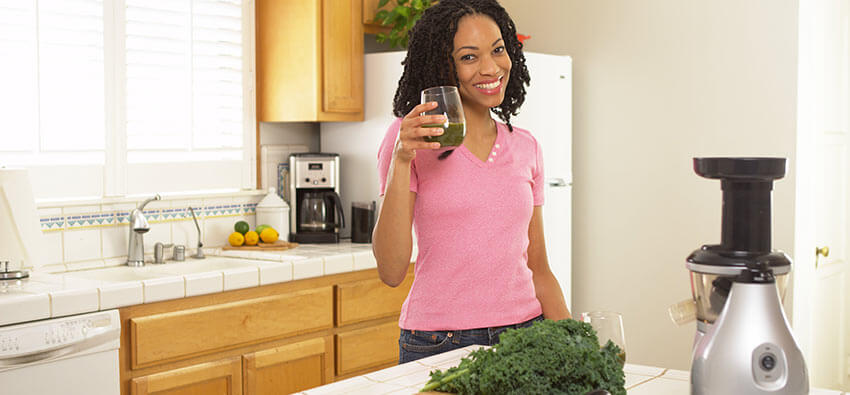
Green juice has become popular, due to the high levels of vitamins & minerals that can be easily absorbed through its regular consumption.
You can buy ready-made juices, but they don’t always contain the highest levels of nutrients because they are often pasteurized to retain shelf life.
Making your own green juices at home, from fresh leafy greens, is the best way to ensure maximum nutrition and quality of ingredients, and to do this you need a decent juicer that can adequately juice your greens for you. Below are the best green juicers available on the market.
| Name | RPM | Weight(Pounds) | Our Rating |
|---|---|---|---|
| Omega J8006 | 80 | 17 | 9.4 / 10 |
| Omega VERT VSJ843QR | 43 | 9 | 9.2 / 10 |
| Omega NC800 HDS | 80 | 20 | 9.2 / 10 |
| Omega J8005 | 80 | 17.5 | 9 / 10 |
| Omega NC900HDC | 80 | 17.5 | 9 / 10 |
| Tribest Green Star Elite GSE-5000 | NA | 24 | 8.8 / 10 |
| Tribest SW-2000-B | 47 | 18 | 8.8 / 10 |
| Kuvings B6000S | 60 | 14 | 8.4 / 10 |
| Breville BJS600XL | 80 | 14 | 8.2 / 10 |
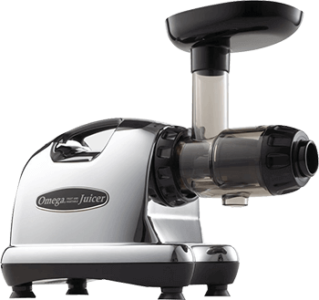

The Omega J8006 is ideal for using with leafy greens because it is a masticating juice. It operates at a very low speed of just 80 RPM, which helps to prevent oxidation from occurring and damaging nutrients during the juicing process.
This machine is made from a mixture of chrome and a specialised type of plastic called Ultem plastic, which has been designed to be far tougher than many others available.
The shaft in which the auger resides is horizontal and pulp is expelled from the very end, out of the adjustable end cap, whilst the juice is released into a receptacle that sits directly underneath the shaft.
The Omega J8006 also comes with attachments that allow for maximum versatility and means that you only need to purchase one piece of equipment instead of three or four.
The attachments include a food processor and grinder. With these extras, you can create all kinds of foodstuffs, such as baby food and nut butter, as well as being able to grind coffee.
Specifications:
This juicer measures roughly 7-inches wide, 12.5-inches high and 16-inches long, when fully assembled, and it weighs 17 pounds.
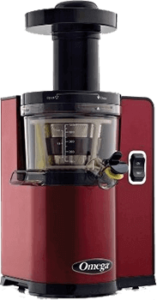

The Omega VERT VSJ843QR comes in a sleek red colour and is a beautifully compact, vertical juicer, making it perfect for small spaces. It stores away in a cupboard far more neatly than horizontal, rounded designs.
The vertical auger acts in a self-feeding manner to pull produce down into the main shaft from the feed chute. Being a masticating juicer, combined with the incredibly slow 43 RPM, it will produce the best possible quality juice from your leafy greens.
Clean up is easy with this juicer: the removable parts are dishwasher-safe, although it is recommended that you wash the mesh screen by hand using a cleaning brush.
The juicing bowl has measurements to let you see at a glance how much juice you have created, allowing you to produce exactly what you need. This juicer can also be used to make sorbets, nut milks and smoothies.
Specifications:
This juicer measures 7-inches wide, 8.5-inches deep and 15.5-inches high, weighing roughly 9 pounds.


The Omega NC800 HDS comes in a silver finish that is sure to look sleek in any kitchen. It is a masticating juicer that operates at a low speed of just 80RPM, allowing it to reduce the level of oxidation that occurs during the juicing process. This also makes it ideal for juicing leafy greens due to the fact that it squeezes and grinds to release juice, as opposed to shredding.
The auger sits in a shaft that is horizontal; the pulp is comes out of the end cap, whilst the juice is released into a container that sits right underneath the shaft.
The five settings allow you to select the right level of pressure for the produce you are juicing, which helps to ensure maximum juice yield.
This juicer comes with a number of attachments that allow you to make breadsticks, nut milks, baby food, pasta and more. It also has a cleaning brush, food pusher and containers for catching the pulp and juice. The removable parts are dishwasher-safe, allowing you to ensure that your juicer remains hygienically clean.
Specifications:
This juicer measures 6.5-inches wide, 14.5-inches long and 15.5-inches high, weighing roughly 20 pounds.
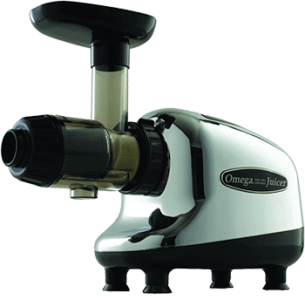

The Omega J8005 operates at a low speed of 80RPM, which ensures that heat production is kept to a minimum and that oxidation is reduced.
The single auger is located in a horizontal shaft directly under the feed chute and is made from strong Ultem plastic, that is designed to withstand heavy use. All of the removable parts are dishwasher-safe, which allows you to keep the juicer hygienically clean.
This juicer comes with additional attachments, such as a pasta nozzle, that allow you to produce pasta, grind coffee beans and blend nuts. A breadstick nozzle means that you can also create breadsticks and rice cakes.
In order to use the juicer for mincing, blending or making pasta, you simply remove the juicing screen and replace it with the blank screen, as well as attaching the relevant nozzle and then operating the machine.
Specifications:
This juicer measures 7-inches wide, 15.5-inches long and 14.5-inches high, weighing roughly 17.5 pounds.


The Omega NC900HDC operates at a low speed of roughly 80RPM. It can operate at this slow speed because it is a masticating juicer, so it presses and squeezes your produce to release the juice.
The juicer is versatile thanks to the various attachments that come with it, allowing you to grind, mince and even make pasta.
The feed chute is larger than on some other juicers, which enables you to save time on preparing your leafy greens for juicing and it also comes with a food pusher.
This machine has a dial on the side that lets you adjust the pressure to suit the foodstuff you are processing, ensuring maximum efficiency. It also comes with containers for collecting the juice and pulp, as well as a cleaning brush for the mesh screen.
Specifications:
This juicer measures roughly 6.5-inches wide, 15.5-inches high and 14.5-inches long, weighing 17.5 pounds.


The Tribest Green Star Elite GSE-5000 has been designed in such a way as to simulate the masticating process of human teeth. It has three different recesses within the gears that simulate the slicing, cutting and crushing functions of the incisors, canines and molars respectively.
It is a triturating juicer because of the twin augers that interlock, effectively crushing and squeezing your leafy greens between them to produce the optimum level of juice.
This juicer comes with a number of attachments that allow it to be incredibly versatile. It has four different screens that provide maximum control over the amount of pulp you want in your juice, a breadstick maker, pasta press and an adjustable soft fruit outlet. The removable parts are dishwasher-safe.
It also comes with food pushers, a glass juice jug and cleaning brush.
Specifications:
This juicer measures roughly 7-inches wide, 18.5-inches long and 12.5-inches high, weighing 24 pounds.
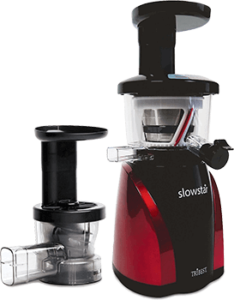

The Tribest SW-2000-B operates at one of the lowest speeds possible, 47RPM. A mincing attachment means that the juicer is versatile and can be used to produce things like pate and nut butter.
The mesh screen, through which the juice is expelled, is made from tough Ultem plastic, which is designed to ensure that you do not see little bits of shredded plastic in your juice, as can happen with some juicers. The auger is also made from Ultem plastic.
Unlike many juicers, this particular one has an upright auger and shaft, instead of a horizontal one. This is designed to help the juicer self-feed and thus reduce the pressure needed from you to force produce into the feed chute, something that can damage your juicer, but can also be uncomfortable for people with injuries.
The juicer also comes with a cleaning brush and containers for collecting the juice and pulp. A juice cap prevents the juice from being released into the container until you are ready for it to do so; this has the added benefit of allowing you to properly mix the juice before serving.
All of the removable parts are dishwasher-safe.
Specifications:
This juicer measures 8-inches wide, 8-inches deep and 18-inches tall, weighing roughly 18 pounds.
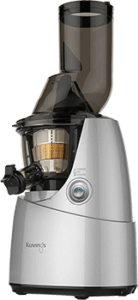

The Kuvings B6000S is a masticating juicer that operates at a low speed of just 60RPM, whilst the vertical auger makes it easy to feed produce into the juicer because it uses gravity to help pull the produce down into the auger shaft.
If anything does happen to get clogged, the reverse option helps to remove the blockage without the need to take the entire juicer apart mid-juicing. As well as creating fresh juice from leafy greens, you can use the sorbet attachments to create delicious fruit sorbet that is a healthier alternative to ice-cream.
The juicer comes with a handy cleaning tool set that has been specially designed to get your juicer thoroughly clean. If you want a quick clean between different juice batches, you can simple use the easy clean function, which is as simple as ensuring that the smart cap is closed, pouring water into the chute, running for about 30 seconds and then draining the water by opening the smart cap.
Specifications:
This juicer measures 8.9-inches wide, 8.1-inches deep and 17.6-inches high, weighing roughly 14 pounds.


The Breville BJS600XL operates at a slow 80 RPM and is designed to reduce oxidation that occurs during the juicing process.
Its two step safety start ensures that children don’t accidentally operate the juicer. It also protects you from injury or causing a mess should you try to start juicing before everything is properly in place.
Unlike many other juicers, this particular model allows some of the fiber to remain in the juice in order to create a thicker, more satisfying beverage that is sure to leave you feeling full and ready to start your day.
A reverse option on the juicer helps you to unclog the auger should your leafy greens become stuck without needing to take it apart.
This juicer can be easily cleaned in between making different juices by simply pouring water into the feed chute and running the motor for a few seconds. This removes the need to completely disassemble and clean the juicer in order to make a different type of juice.
It comes with a cleaning brush and containers for collecting the pulp and juice.
Specifications:
This juicer measures roughly 8.5-inches wide, 7.5-inches deep and 16-inches high, weighing 14 pounds.
When it comes to leafy greens, you don’t really want to use a centrifugal juicer, which is designed to grate and shred fruits and vegetables to create juice. This is because it simply won’t work very well with leafy greens, which don’t shred especially well. Leafy greens should ideally be squeezed and pulverized to release the juice that they contain. There are two kinds of juicer that are best designed for this purpose: masticating and triturating.
Masticating juicers are perfect for juicing leafy greens because, as their name suggests, they essentially grind and chew up the produce, squeezing it with such force that every possible drop of juice is expelled. After all, mastication is the process of chewing, it is exactly what we do when we eat to prepare our food for digestion.
This kind of juicer works at a far slower pace than centrifugal juicers, due to the nature of their operation. This has the added benefit of reducing the oxidation (which can cause damage to the nutrients in the juice) that occurs during the juicing process.
Masticating juicers contain something called an auger, which basically looks like a large screw, and it is this device that pulls your leafy greens from the feed chute into the central chamber where they are slowly crushed between the auger and the body of the chamber.
The leafy greens are eventually pushed through a mesh screen where the juice is separated from the pulp. The pulp is usually very dry, although some people like to push it through the juicer again to extract optimum levels of juice.
Masticating juicers will sometimes have reverse functions on them which is handy if anything gets stuck or clogs the machine, making them a lot easier to operate than centrifugal juicers that often have to be taken apart to be unclogged.
Masticating juicers come in a variety of designs and tend to be more robust than other types on the market, such as centrifugal juicers. Their robustness is understood to be due to the fact that they operate at a much slower speed than centrifugal juicers, so are far less likely to overheat. Plus, the augers and the chamber they sit in tend to be made from tough material, like steel and Ultem plastic. These juicers are also incredibly quiet and fairly easy to take apart and clean.
There are some negatives to masticating juicers and they include the fact that they take longer to produce juice than centrifugal juicers and are often much more expensive to buy. But if you are serious about juicing leafy greens to maintain optimum health, then they are a worthwhile investment.
These are the ultimate juicers when it comes to juicing leafy greens. They are essentially masticating juicers in the sense that they grind and squeeze produce to release the juice and they also operate at a very low speed and are made from strong materials, like Ultem plastic.
But unlike regular masticating juicers, triturating juicers have two augers that interlock and create an impressive force that squeezes the leafy greens in a manner similar to how a mangle will squeeze water out of laundry.
Triturating juicers tend to be more expensive and therefore are probably best left to those hardcore green juice fans who will make the most out of them. That said, if you can afford to buy one, then you should because they are an amazing investment in your health and, just like with masticating juicers, can be used for juicing every type of fruit and vegetable, not just leafy greens.
There are numerous benefits to owning a juicer that is well equipped for juicing leafy greens and they include:
Good investment – ready-made, store-bought juices can be expensive, as well as nutritionally inferior to fresh, home-made juices. Sure, a masticating or triturating juicer is likely to cost you quite an initial outlay, but that investment in your health will be repaid with interest when you consider that you will be healthier and saving money in the long-term.
Quality – as previously mentioned, juice that is made fresh and consumed immediately will have far more nutrients than one that has been pre-made, pasteurized and stored on a supermarket shelf for days.
Control and versatility – unlike with store-bought juices, you have total control over the quality and type of ingredients that you put into your juice. This means that you can tweak and adapt your juice to whatever your needs are that day, as well as ensuring that it tastes exactly how you want it to.
Batch juicing – this is particularly relevant if you are using a masticating or triturating juicer because they significantly reduce oxidation which in turn allows you to produce juice in batches and keep it in the fridge for a period of time, usually a day or two. This also makes it easier to plan and stick to a juicing or diet regimen, compared to having to make juices up at intervals throughout the day, because you can get all of the hard work out of the way in one go.
When it comes to deciding which juicer to buy for producing green juice from leafy greens, there are a few things that should be considered, not least of all the type of juicer that you will need.
Ordinarily, you will opt for a masticating juicer. If your budget can afford it, a triturating one is ideal. They are best designed for releasing juice from leafy greens.
However, there are other things that should be given some thought and they include:
Intended use – this might seem obvious, but if you want your juicer to do more than just juice leafy greens, then this is something you need to think about. What will your juicer actually be used for? Do you intend to only juice leafy greens, or do you want something that can not only juice anything you put into it, but that also comes with attachments for producing baby food, nut milks, pasta and the like?
Budget – again, probably another obvious one, but deciding on your budget is key when purchasing your juicer. Budget tends to go hand-in-hand with intended use of your juicer because you want to ensure that you get the best value for your money. Work out what your priorities are and then try to find something that you can afford.
Practicality – what we are referring to here is how easy the juicer is to use – how simple it is to take apart and put back together, whether or not you can put any parts in the dishwasher, how easy the mesh screen is to keep hygienically clean and if you have the space to store it. These are things that all need to be considered when deciding which juicer to buy.
Warranty, materials etc. – what will your juicer be made from? If you’re concerned about BPA materials in your food storage and preparation equipment, then you’ll obviously want to steer clear of a juicer that contains such materials. You also need to check the warranties that come with your juicer; some will have restrictions, whilst others have lifetime warranties and others, still, have varying warranties in relation to parts, labour and the motor, so it’s important to establish whether or not you want to be protected should anything go wrong with your juicer.

There are numerous benefits associated with the consumption of green juice, although exactly which benefits you will experience depend greatly on the ingredients you use. That said, some of the benefits to juicing and drinking leafy greens at home include:
Maximum nutrition – when you make your own juice at home, you can be assured of the quality of your juice. You get to decide exactly which ingredients to use and, therefore, which nutrients you will be getting. Plus, consuming the juice straight away will usually allow you to absorb the maximum level of vitamins and minerals compared to buying shop-bought, pre-prepared juices.
Low in sugar – generally speaking, green juices are made primarily or entirely from leafy green vegetables so there is far less sugar in them compared to any other beverage; even homemade fruit juices still contain a fair amount of naturally occurring sugar, which can be detrimental to your health if consumed in large quantities on a regular basis. This makes green juices ideal for anyone trying to improve their health and lose weight, as well as people with conditions like diabetes. In fact, a study conducted by Dr. Lydia Bazzano et al. found that increasing consumption of leafy greens helped to lower the risk of developing type 2 diabetes.
Helps reduce cholesterol – a small 2008 study found that supplementing the diet of men who had high cholesterol with kale juice for three months helped to reduce LDL (“bad”) cholesterol by around 10% and improved levels of HDL (“good”) cholesterol by as much as 27%. It is not clear if this same effect would be achieved with other leafy greens, but it certainly argues the case for regularly including kale into your green juice.
High levels of chlorophyll – green vegetables contain the highest levels of chlorophyll of any fruit or vegetable, a compound that is essential to maintaining a healthy body. There have been numerous studies into the effects of chlorophyll on the body, but most notable is perhaps the fact that it can help to protect the body from carcinogenic compounds, as well as helping to improve the liver’s detoxifying qualities, as evidenced in a 2003 study conducted by Dingley et al.
If you suffer from a medical condition, it is important to speak to a qualified health professional and ask them if it is safe for you to regularly consume green juice.
Ensure that you use your juicer correctly by read the instructions that come with it and do not use it for anything other than its intended purpose. Keeping your juicer hygienically clean is also very important.